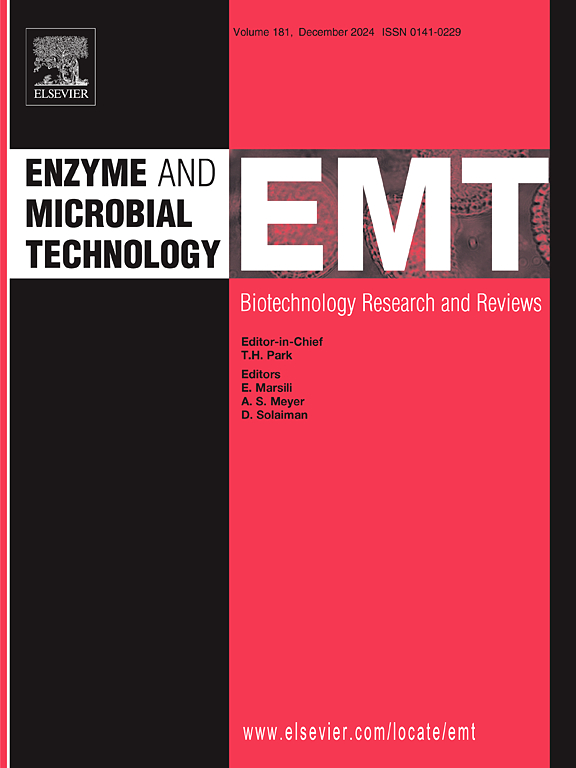Microbial community analysis of the biofilms of both working and counter electrodes in single-chamber microbial electrolysis cells
IF 3.7
3区 生物学
Q2 BIOTECHNOLOGY & APPLIED MICROBIOLOGY
引用次数: 0
Abstract
This study was conducted to delineate microbial community development and composition on both working and counter electrodes in single-chamber microbial electrolysis cells (MECs) using synthetic wastewater. Two separate bioelectrochemical reactors were inoculated with anaerobic sludge. The first was operated at an anodic potential poised at + 0.4 V and the second one at a cathodic potential poised at −0.7 V, both vs. an Ag/AgCl reference electrode. The performance of the MECs, including current generation, bioelectrochemical activity of the biofilms on both the working and counter electrodes, and chemical oxygen demand (COD) depletion were monitored over the last 45 days of operation. Scanning electron microscopy (SEM) and 16S rRNA gene sequencing were performed to delineate the development and morphology of the microbial communities on both the working and the counter electrodes. The current generated at the anodic working electrode provided evidence of the growth of anode-respiring exoelectrogens (Clostridium sensu stricto). Similarly, the Faradaic current data at the cathodic working electrode confirmed the formation of an electroactive biofilm dominated by acetoclastic and hydrogenotrophic methanogens (Methanothrix and Methanobacterium). Microbial communities on the counter electrodes were found to be richer but less diverse compared to those on the working electrodes. These communities were likely influenced by the fluctuating potentials at the counter electrodes. SEM observations were consistent with the microbial analysis. These findings demonstrate the ability of a mixed inoculum to shift towards anode-reducing and cathode methanogenic communities using a complex substrate on a constant working electrode and varying counter electrode potentials.
单室微生物电解池工作电极和反电极生物膜的微生物群落分析
本研究旨在描述利用合成废水的单室微生物电解池(MECs)工作电极和反电极上微生物群落的发育和组成。两个独立的生物电化学反应器接种厌氧污泥。第一个电极在+ 0.4 V的阳极电位下工作,第二个电极在−0.7 V的阴极电位下工作,两者都与Ag/AgCl参比电极相对。在过去45天的运行中,对mec的性能进行了监测,包括电流的产生、生物膜在工作电极和反电极上的生物电化学活性以及化学需氧量(COD)的消耗。通过扫描电子显微镜(SEM)和16S rRNA基因测序来描绘工作电极和反电极上微生物群落的发育和形态。在阳极工作电极上产生的电流提供了阳极呼吸外电菌(严格感梭菌)生长的证据。同样,阴极工作电极上的法拉第电流数据证实形成了一种电活性生物膜,主要由醋酸破酯菌和氢营养产甲烷菌(Methanothrix和Methanobacterium)组成。与工作电极相比,反电极上的微生物群落更丰富,但多样性更低。这些群落可能受到对电极波动电位的影响。扫描电镜观察结果与微生物分析结果一致。这些发现证明了混合接种物在恒定的工作电极和不同的反电极电位上使用复杂的底物向阳极还原和阴极产甲烷群落转移的能力。
本文章由计算机程序翻译,如有差异,请以英文原文为准。
求助全文
约1分钟内获得全文
求助全文
来源期刊

Enzyme and Microbial Technology
生物-生物工程与应用微生物
CiteScore
7.60
自引率
5.90%
发文量
142
审稿时长
38 days
期刊介绍:
Enzyme and Microbial Technology is an international, peer-reviewed journal publishing original research and reviews, of biotechnological significance and novelty, on basic and applied aspects of the science and technology of processes involving the use of enzymes, micro-organisms, animal cells and plant cells.
We especially encourage submissions on:
Biocatalysis and the use of Directed Evolution in Synthetic Biology and Biotechnology
Biotechnological Production of New Bioactive Molecules, Biomaterials, Biopharmaceuticals, and Biofuels
New Imaging Techniques and Biosensors, especially as applicable to Healthcare and Systems Biology
New Biotechnological Approaches in Genomics, Proteomics and Metabolomics
Metabolic Engineering, Biomolecular Engineering and Nanobiotechnology
Manuscripts which report isolation, purification, immobilization or utilization of organisms or enzymes which are already well-described in the literature are not suitable for publication in EMT, unless their primary purpose is to report significant new findings or approaches which are of broad biotechnological importance. Similarly, manuscripts which report optimization studies on well-established processes are inappropriate. EMT does not accept papers dealing with mathematical modeling unless they report significant, new experimental data.
 求助内容:
求助内容: 应助结果提醒方式:
应助结果提醒方式:


